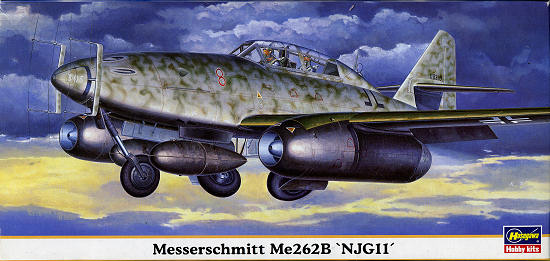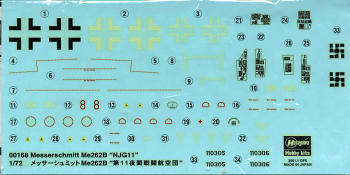
Hasegawa 1/72 Me-262B "NJG 11"
| KIT #: | 00168 |
| PRICE: | I paid $9.00 from the 'used' bin. MSRP probably more. |
| DECALS: | Two options |
| REVIEWER: | Scott Van Aken |
| NOTES: | Limited reissue (2001) |

| HISTORY |
| THE KIT |
Prior to Hasegawa releasing their Me-262 series, the two seat version was available in 1/72 from Jo-han and a bit later from Heller. It is the Heller kit that was the most highly sought and could be made into a fine representation of this aircraft. Since then, Hobby Boss and perhaps Academy have released it.
Hasegawa's kit is typical of their products in the early 1990s, with engraved panel lines and the use of decals for cockpit instrumentation. The detailing is a bit on the heavy side with several items like the flare dispensers and gun covers being somewhat thick when they should be nearly flush. The kit also has enclosed wheel wells and on the real aircraft, the center section is quite open. The cockpit itself has a pair of seats and the appropriate instrument panels for the pilot and radar operator. Figures are provided for the seats, leaving them rather barren if one does not include the figures.
The wings do not have
extended flaps or slats, which is not unusual for Hasegawa. Landing gear is well
molded with the nose gear having the wheel integral with the strut. The cockpit
canopy is designed to be displayed open, despite the lack of real detail.
 It is a
simple matter to cut the protruding tab for a closed display. Hasegawa supplies
a length of wire that is to be cut into 11mm sections for the radar aerials.
There are grooves in the aerial base section for these bits to fit. The
night fighter version normally carried but two cannon and the optional nose is
provided.
It is a
simple matter to cut the protruding tab for a closed display. Hasegawa supplies
a length of wire that is to be cut into 11mm sections for the radar aerials.
There are grooves in the aerial base section for these bits to fit. The
night fighter version normally carried but two cannon and the optional nose is
provided.
The standard Hasegawa instructions provide the usual Gunze paint references and are well drawn. Markings are given for two planes from 10./NJG 11. Both have matte black undersides. One has an upper surface of RLM 76 with somewhat open RLM75 squiggles. The other has RLM 75 upper wings and tailplanes with the fuselage in a snake-like pattern, also in RLM 75. The decal sheet is well printed and the 'old' style from Hasegawa where the white is actually off white. However, it makes no difference on this scheme, though I've found their markings to be somewhat translucent so it might be a good idea to apply them prior to the fuselage and wing squiggles.
| CONCLUSIONS |
This is a kit that can still be found without too much difficulty and does make into a very nice model once complete. It is a relatively quick build, not very fiddly and with various aftermarket bits available for those that are into adding more detail.
December 2008
Once again, you can thank your editor for providing this one for preview.
If you would like your product reviewed fairly and quickly, please contact me or see other details in the Note to Contributors.